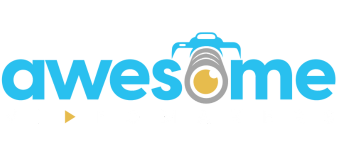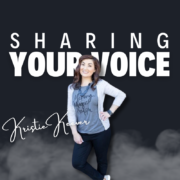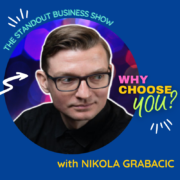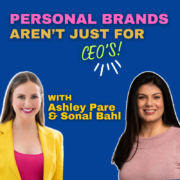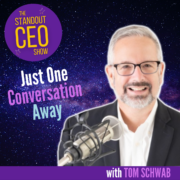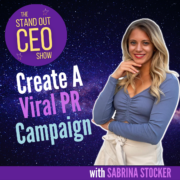153. Let’s turn your voice & vision into an industry leading brand with Kristie Keever
What does it really take to build a standout personal brand?
And what if your personal brand was really the key to unlocking endless opportunities?
In this edition of The Standout Business Show, we uncover the secrets to building a memorable brand with the help of top brand strategist and online business coach Kristie Keever. (yes, she’s helped online marketing icons like Amy Porterfield develop their brand!)
So, if you’ve ever wondered how to structure your brand for maximum impact…
…then you should join us because Kristie breaks down her 6 key pillars to building your personal brand that’ll grow a high performing & highly profitable business.
Stay tuned for an engaging conversation that promises to elevate your branding game!
Resources:
Connect with Kristie Keever: kristie@freshlystated.com
New Free Training: The Art of the 5-Minute Video
Learn how to share everything you know in 5 minutes or less. As an expert, you’ve got a ton of knowledge, methods and frameworks that you’ve honed and now you can learn how to share all of it in a clear, concise and personable way – in 5 minutes or less.
In just three 5-minute videos you’ll learn:
- How to set yourself up on camera to look and sound as professional as you can
- What to say & how to structure your video so people will not only watch but be inspired to take action
- The #1 thing to say in your video that will ensure people remember what you said
SUBSCRIBE TO THE PODCAST:
Transcript
Kristie Keever:
I think probably one of the big tragedies of the human race is that, even though we want to be seen and heard, we’re mortally afraid of it. I like to tell my clients and students to think of yourself not as the spotlight, but more as the vehicle for the message. You have value, you have experience, you have lessons. You have so many great things, so many years of wisdom that you can share with others and that can help one person save so many years or lots of money or extra steps, or whatever the case is. You can help them in some capacity, but you can’t help them if you’re not sharing the lessons, if you’re not sharing the stories. It isn’t actually about you. It’s about what you know, what you’ve been through, so that you can use that information to help others.
Brad Powell:
Welcome to the Standout Business Show, the show that’s all about getting your brand out there for business leaders who refuse to blend in. Your brand out there for business leaders who refuse to blend in. I’m Brad Powell, and today we’re talking about what it really takes to build a standout personal brand by sharing your authentic voice online. My guest today is brand strategist and online business coach, christy Kiever, and she believes that building a strong personal brand is simply about consistently making a connection with the right crowd. So stay tuned because she’s going to break down her six key pillars to building your personal brand that grows a high performing and profitable business. So if that sounds good, stay tuned and let’s start the show. All right, christy, welcome to the show.
Kristie Keever:
Thank you so much for having me.
Brad Powell:
All right. So to get us started, something that I have heard you talk about and, in fact, the way I came across you was because you were on another podcast and talking all about your six pillars and the thing that stuck out to me especially early on in the conversation was your approach to what I’m going to frame as relationship marketing that you were taking back to when you were getting started. The thing that you did most was a lot of networking and a lot of building relationships. So talk about that from a perspective of you know people think, well, if I’m going to grow my personal brand, they have a bunch of things in their head about what that might mean, and I think your approach is pretty distinctive in terms of how you’ve done it for yourself and, of course, now how you’re doing it for clients.
Kristie Keever:
Yeah, this is my favorite thing to talk about, so I’m so glad you asked. When you think about business and you think about success, it really comes down to very basic things, and that is the power of connection. It is about letting people hear you, letting people see you, letting people get to know you. So it’s building off of know, like and trust factor, and the only way to do that is to make connection with people.
Kristie Keever:
Right, you have to put people first, and so the strategy that I use in regards to networking is just going out and doing everything that I can to allow people to get to know me, to understand who I am, what I’m about, what I’m doing, what I do for others, et cetera, and not focusing on making a sale at all, but rather focusing on making a connection with people. So not trying to sell a business or gain a client or anything like that, but really just making it about tell me about yourself. What is it that you do, why do you do that and what can I do to help you accomplish what your goals are? And so when you focus on that, you’re focusing on building relationships and whether somebody actually is a good fit, good target audience or a potential client it all comes back to. If I like you, I’m going to refer you to others who I come across that might need you or your services, right?
Brad Powell:
Yeah, exactly, I think when I go to particularly large events or even a small, you know, networking gathering the mistake I see people make and I have a friend who teaches networking and she refers to these folks as skunks they come into a group of people and they’ve got their business cards in a stack in their hand and before they even basically say, hello, who are you? They go here, would you like my card? And they just kind of spray skunk-like the entire room with all their business cards.
Kristie Keever:
That is fantastic. I’m going to remember that. That’s a really great description. Yes, I like to call them sometimes also drive-bys.
Brad Powell:
Right, there you go, yeah Right.
Kristie Keever:
Drive-by that and you have.
Brad Powell:
Right, there you go. Yeah Right, drive-by that, and you have the person that you’re talking to and while you’re talking to them, they’re spending all their time like looking over your shoulder to see who else is in the room and you’re going oh my gosh, this person doesn’t care, absolutely, absolutely.
Kristie Keever:
But then you have the opportunity to connect with somebody who is looking straight into your eyes and asking you genuine questions, like they’re truly interested, then that’s where it’s in your best interest to invest in that person in that time, in that moment.
Brad Powell:
Yeah, I know for myself that when I go to an event and sometimes these conferences will last multiple days, so you’d be there for two or maybe even three days I feel like if I come away with one solid new friendship like really genuine I’ve met somebody that I really connect with and that person is going to become a friend for the future, like for if that’s what’s happening as a result of this event, then it’s a huge success, like that’s great, absolutely.
Kristie Keever:
Absolutely.
Brad Powell:
I think that’s the most valuable things that you can get out of that kind of thing, cause most people they’re just so busy like running around and feeling like oh no, I’m missing out on something that’s over there, and that kind of thing. That kind of energy can be really contagious and it’s really hard to avoid. And so for me it’s like, well, what really fascinating, interesting, wonderful person am I going to meet here, and good things will probably come from that.
Kristie Keever:
That’s it. That is the attitude and the mindset to go in with it. And I do the same as you or similar. My focus, especially if I’m doing a multi-day event, then my focus is to connect with three or four quality people that I truly can say I would love to have coffee with you. Let’s be accountability buddies. Let’s, you know, do everything that we can to try to get to know each other as a person and as a business owner at the same time, so that we can help each other. You feel connected to certain people, so people give off a certain type of energy that you’re attracted to naturally, and so when you see those, I like to call them coffee buddies or coffee dates, because they’re the kind of people that you can connect with over the years, meet to have coffee and feel like no time has passed at all.
Brad Powell:
You know, just two weeks ago I was talking to someone who was her whole business is all around helping people get referrals, and what surprised me about her approach was she was basically really adamant about you never ask for a referral, and she was talking about the human psychology behind why someone would refer you. And the what she was saying was that there’s this thing where when you’re genuinely helping someone else like someone comes to me with a problem and they say I have this problem and I need to solve it in this way, and you’re sitting there going I want to help, help, but what they’re talking about? The thing that they need? I’m not the person to help them, but I know somebody who is.
Brad Powell:
And so in that moment, first of all, when you come to the person and you’re hearing this stuff, the referral person is not in the conversation. It’s not like, oh, I’ve got five people that I’m going to go around recommending, I guess in the way way that BNI does, you know, like I’ve got a mission every week that I have to make recommendations, like people don’t function that way, I don’t think. And so she was saying that what the reward center is that I am going to feel good because I can help my friend in this moment because I know Christy does personal branding terrifically well and so if this person had that problem now, I can recommend Christy to him or her and that’s really helpful to my friend. But I’m feeling terrific because I’m helping my friend.
Kristie Keever:
Absolutely. You feel like a good deed is done, You’ve been helpful. As humans, there are two core things that we really want. That fulfills us right. We want to be seen and heard and we want to feel valued. And so we feel valued by contributing, by helping out, lending a hand, helping somebody accomplish something that they’re trying to do, even if it’s the smallest role or the smallest part, and even if we don’t know for sure how it’s going to work out. But we know we did a good deed and that’s what feels really good.
Brad Powell:
You just mentioned, we all want to be seen and heard, which I think is totally true.
Brad Powell:
Like everyone has that in them and, at the same time, I think probably one of the big tragedies of the human race is that, even though we want to be seen and heard, we’re mortally afraid of it.
Brad Powell:
In most cases, people have this like no, I’m not the person who should be like in the spotlight and so and I want to bring it back to the conversation about personal branding so business people have some awareness now because of books like Brand Called you and all this other stuff that they like as the leader of their business, they’re probably the most valuable marketing asset of the business just who they are and themselves and their reason for being and why they’re doing the thing they’re doing. And they feel like, yeah, I need to get my face out there and be the face of the brand, like be the representation for this thing that we’re doing, this mission that we’re on. And so when you’re helping people, like just in the beginning, figure out like what are the steps to establish what your personal brand is that will actually make them more comfortable with this thing that they’re afraid of in terms of actually being seen and heard?
Kristie Keever:
Well, step number one is talking about mindset and perspective. So a lot of people are afraid to be seen because they don’t want it to be the all about me show. I don’t want it to be about me. I don’t want my face everywhere, I don’t want people to think that I’m better than anybody else or whatever it is that they’re going to think. Right, there’s still a lot of that seeking you know, receiving.
Kristie Keever:
You know what others, how others see you or how others value you, and so the first thing that we talk about is mindset and perspective, and I like to tell my clients and students to think of yourself not as the spotlight, but more as the vehicle for the message, because it’s all about.
Kristie Keever:
You have value, you have experience, you have lessons, you have so many great things, so many years of wisdom that you can share with others and that can help one person save so many years or lots of money, or extra steps or whatever the case is, you can help them in some capacity, but you can’t help them if you’re not sharing the lessons, if you’re not sharing the stories, if you’re not sharing the nuggets, et cetera, and so if you can think of yourself as just the vehicle for delivering the message, delivering the story, so that people can use that information to help achieve their own outcome. Then we start to see things from a different lens, to allow us to not feel so self-conscious about actually sharing, because it isn’t actually about you. It’s about what you know, what you’ve been through, so that you can use that information to help others.
Brad Powell:
Yeah, I love that. It’s not about yourself, it’s really about them and the things that you can use that information to help others. Yeah, I love that. It’s not about yourself, it’s really about them, and the things that you can communicate are really much more around how and why you understand them Exactly, and this applies to any industry, any type of information.
Kristie Keever:
It’s what do we have to share with others? And I don’t know about you, brad, but I’ve talked to thousands of people over the years. Everybody has a phenomenal story and really great lessons they’ve learned along the way.
Brad Powell:
Yeah, absolutely they do, and you know it’s interesting.
Brad Powell:
I do a lot of work around storytelling because my work is all with video and it’s certainly probably the best way to communicate with people is to share stories of all kinds, and I think the interesting thing there is that when people think about, well, what is my story?
Brad Powell:
Or I don’t really want to tell my story, when they’re sort of feeling blocked. That way, the story that you tell doesn’t have to be anything epic, it doesn’t have to be this big giant deal. You don’t need to have flown to the moon or climbed Kilimanjaro or whatever the heck. It’s not necessary to have a good story and in fact the story part can be like really small anecdotes that simply communicate a part of your personality and a part of your values that people can relate to, and that’s kind of where the connection happens. So I want to get to like. I know that you have this unique methodology of how you bring people through a brand building process that you call Elevate. So let’s go there for a minute and kind of give us the 10,000 view of what Elevate actually is those pillars.
Kristie Keever:
Yeah, absolutely so. The core pillars are really the foundation to your success. Whether you’re building a personal brand, you’re building a business. When you think about building something successful, think of it similarly to building a house. You don’t. Similarly to building a house. You don’t want to build a house, or you want to build a structure if you don’t have a proper foundation set first, because that foundation is going to determine the longevity or the lifespan of your business or your structure. And so I developed this. So I developed this. It’s a course six method where there’s six key pillars to this foundation to make sure that you’re building on this proper foundation.
Kristie Keever:
So pillar number one is your vision. You want to make sure that you are very clear on what it is that you’re building, why it is that you’re building it, what kind of impact you want it to have and for who, so that you’re very clear on the direction that you’re going. Where do you want this to be three to five, 10 years from now? Down the road, if you don’t know where you’re going, you don’t have a destination. Then you’re not able to determine the steps that you’re taking today or the path that you’re carving now is actually going to help you to accomplish those goals. So when you hear people say, begin with the end in mind, this is exactly what they’re referring to and what they’re talking about. Because you want to be clear on that vision so that it gives you the direction that you need to easily say yes or no to opportunities or things that come across your path along the way. If it’s not going to align you with the outcome or objective, then it’s an easy no, and if it is, it’s got to be a heck yes or no. Thank you there too, right?
Kristie Keever:
So visions first and foremost. The second one, then, is your target audience. So you have to be really clear on who it is that you’re speaking to and who it is that you’re designing this for. And there’s two sides to this target audience that not a lot of people talk about. Side number one is your basic demographics. Those are still important, they still matter. You want to know the gender, the location, the income level. You want to make sure that you’re in the right category of demographic first, but the most important side of that is actually psychographics, or this is the reason why people buy the thoughts, the feelings, the emotions, et cetera. So you really want to understand your demographic on a very deep, very intimate level. What are they dreaming about? What are some of the drains that keep them up at night or the doubts that might be having in their mind? The clearer you are on that, the easier than it is to attract them and speak to them.
Kristie Keever:
Then the third pillar is defining what your offers are. What are the steps that you’re taking them through on that journey from A to C to help them accomplish or achieve that outcome, goal or objective that you particularly can help them to achieve? So you want to have that value ladder or that suite of offers outlined so that you’re very clear on what segment of your audience you can help at what point in time, to achieve that desired end result. Then, once you have those outlined and defined, then you can go into pillar number four, which is messaging. So now you know who you’re talking to, what it is that you’re doing to help them, what is that overall big picture and vision that you’re trying to accomplish, achieve? And now you can start to craft the stories that need to be told in order to grab their attention, keep them entertained, but also convert them into some of your offers, okay. So then, once you have that figured out.
Kristie Keever:
The next step, then, is making sure that your visual branding is on par to actually attract the target demographic that you’re setting out to attract. You know we’re all attracted visually to certain things versus others, and so we want to make sure that your visual branding is actually done in a very strategic manner so it brings a little bit of you in your personal preferences, your personality, and kind of makes it looks and feels like you, but it’s also very attractive to them and who they are, because it’s going to feel like an it should feel like a natural, organic thing. Okay, and then the last step to that, pillar number six, then, is your marketing. How are you communicating, how are you telling those stories? Where are you doing this and in what format? Because not all formats fit your specific individual target demographic.
Brad Powell:
Yeah, that’s a really great progression and I think probably what’s most helpful there is, in fact, that this is done in order. Yes, a lot of people go. Well, I just you know, they get on social media and they start broadcasting. They get in sort of a broadcast mode and saying a lot of stuff without those foundational pieces underneath them, and which means that they end up being kind of all over the map and one day they’re talking about one thing and the next thing they’re on a totally different, you know, bent. And it doesn’t. You know, it just loses cohesion. It does.
Brad Powell:
This is really terrific. I’d like to talk a little bit about your target audience and go a little deeper on the niche, because I think you can come up with these very specific avatars where 40-year-old female who has got three kids and lives in Omaha you know, like you can really drill in that way, however, the mindset and their lifestyle in their daily life and, more specifically, the challenges and the problems that they’re facing and wanting to solve specifically the challenges and the problems that they’re facing and wanting to solve. That seems to be way more important.
Kristie Keever:
So talk a little bit about how people can investigate those kinds of things. Yeah, that’s a great question. So it really comes down to what is the problem that your target audience has that you, individually and uniquely can solve? And everything that you craft, everything that you create, all the stories that you’re telling are targeted towards that problem. So, honestly, I’m the kind of person who doesn’t believe that niche really matters as long as you’re talking to the people who have the problem that you know you can solve and you have the skill set to help them solve that or overcome that. That’s the only thing that matters.
Kristie Keever:
When it comes to niche and your target audience, yes, it is important to understand age range and male, female, that type of thing.
Kristie Keever:
That is important.
Kristie Keever:
And actually that information comes handy when you’re doing paid advertising, because you can get really nitty gritty in some of the details, but if you don’t know that information, it’s hard to do that right.
Kristie Keever:
But when it comes to just getting started or trying to fine tune or refine, focus just on the problem and how you can speak to just that one piece, that one piece, and then that’s going to give you enough information to be able to start to have conversations with people start to ask questions. If you’re one of those action taken, go, get in type of people and you want to start creating content awesome, go for it. But make sure that you’re taking notes along the way to see what kind of questions are people asking. Are they in alignment with where you actually want to be serving and teaching, et cetera. If they’re not, then you need to change the narrative. You need to shift the conversation so that you are getting them in the right channel or in the right direction that you want them to go, because your audience will always give you that feedback if you’re willing to ask the questions or pay attention to the questions that they’re asking in order to determine if you’re in the right spot.
Brad Powell:
I can’t agree with that more. I mean, when people hear about content creation, they really get into this mode of well, I’m going to be a teacher, I’ve got all this knowledge. Hopefully they do. I’ve got all this expertise and I’m going to start sharing that and they get into the teacher like here I am teaching and my take on it, especially in the beginning. But you need to keep on doing this.
Brad Powell:
Ongoing is more of like a documentary filmmaker, where you go out into the world, you have this idea of something that’s going on out there and you are really curious about it and you don’t there. And you are really curious about it and you don’t. You’re not in the role of being the expert necessarily. You’re just super curious to find out a particular kind of thing. And then you’re talking. You’re like you’re having this conversation, like you’re mentioning, like your content is more conversational, your interaction with your audience is extremely conversational and you’re really pulling out.
Brad Powell:
What do they have questions about, what are the things that they’ve tried that worked, what are the things that they tried that failed, and all this kind of stuff. That is just about learning and then being in the role of like I’m going to date myself Indiana Jones and the jewel of the Nile, whatever where you’re going out and you’re finding treasure and that’s what you’re bringing back to your audience and saying look, I went on this journey and I found this cool thing because I talked to all these people and this is what I found, this is what I learned.
Kristie Keever:
Yes, exactly. And not only that, but your audience also loves watching that journey unfold, because they love to be part of that process.
Brad Powell:
Yeah, and I think you know, bringing back to personal branding, like if you you know your version of being that Indiana Jones type character, any kind of explorer who is searching for wisdom and helpful stuff, and then being literally the vehicle for that being a curious creature and a sponge of information, right.
Kristie Keever:
Especially if it’s about a topic or an area that you’re super curious about, then naturally you’re going to ask questions. You’re going to want to know more. Who else can I talk to? What has been your experience? What are some good resources and tools that you would suggest or recommend? I have people ask me all the time what are your top go-to books that you suggest? What are your top podcasts? Or you know, live streaming shows, et cetera, like, where can I learn as much as I possibly can about this as quick as I possibly can? And if you’re collecting that information along the way, then you become a vault over time of tools and information and resources and things that you can share with your audience. That makes them see you as more of an expert and an authority.
Brad Powell:
All right. Well, one last thing I’d like to touch on before our time runs out is in the marketing arena, particularly where the visual element is so prominent. I mean, all marketing, I think, has a visual part. Even if you’re writing copy, how that copy is on the page is a visual presentation. And so, when it comes to branding, this is like super important and I’m really big into this in terms of you know the aesthetic around when you’re on video or when you’re on a podcast, like we’re doing right now. The visual part is all important, even though you know people say no, podcast is an audio medium, and I’m going well, yes, and there’s so much that you can do if you are also creating video alongside this kind of conversation. So speak to just your take on bringing visual elements into pretty much everything you do on the marketing front.
Kristie Keever:
Yeah, so visual, as you mentioned, it is incredibly important and it does need its own attention and space. So you’ve got to take the time to be really thoughtful and very intentional about it. And if you’re not that graphic design person or you don’t have the skill set, you’ve never done it before or think, oh I can, I can kind of put something together. Don’t, it’s okay to do that in the beginning, but you get to a point. If you’re just getting started and you’re bootstrapping your business, absolutely fine, there’s nothing wrong with that. But keep it very simple Two colors, two fonts and be very consistent with those.
Kristie Keever:
But as you grow in your brand, as you grow in your business, you’re going to feel like you’re outgrowing your look and feel or you’re outgrowing your space and you need to take it up a notch or two. When you get to that point, that’s when it’s time to really invest in somebody who can guide you through that process, who can ask you the right questions, who can connect a lot of the dots for you. And a lot of times, all they’re really doing is showing you what they see there for you but then giving you options of what do you want this to look like? But all of that is based off of strategy, it’s based off of structure. It’s a defined, very highly developed process that you can’t get wrong if you take the time to do it right.
Brad Powell:
Right, don’t be afraid, you can’t get it wrong.
Kristie Keever:
Exactly, exactly. But you also have to keep in mind that it does require your attention and your participation in the process. Like, please don’t go to somebody and say I don’t know what I want to see, but I’ll know it when I see it. That is the worst thing that you can do. Every designer’s worst nightmare right. So you want to have an idea, you want to pay attention to what do? What am I attracted to? What do I like? What do my eyes naturally gravitate to? Start saving? You know ads that pop up on your feed, or backgrounds that you really like or whatever. Make a collection of them, and I like to use Pinterest easiest place to to save things, um, so that when you finally do talk to somebody, you can say I’ve already collected some ideas and a trained designer with the right skill set will be able to see the patterns and show you what’s already there.
Brad Powell:
Yeah, I think that’s great advice. Just literally collecting ideas from around the internet that just strike you like this, for whatever reason, this is what I want. I want to look like this. I you know, for whatever reason, this, this is what I want. I want to look like this. Yes, it was really interesting. You know, from a standing out point of view, most people don’t pay that much attention to this, and so when you see and this is particularly true for the business world and the business world website space Like almost every single, especially the B2B business world all of the websites are blue, they’re all blue and they’re all standing. If there’s anybody on the page as an image, it’s usually not a person from the company, it’s just a generic human, and they’re wearing a suit and they’re standing sort of sides to the camera with their arms crossed, smiling.
Kristie Keever:
I know exactly what picture you’re talking about.
Brad Powell:
We’ve all seen this and like over and over. Like almost no matter where you go, this is the standard thing. So if you take the time to do this kind of thing that you’re talking about, it’s actually not that hard to be quite distinctive and probably really attractive to the right people.
Kristie Keever:
Absolutely, absolutely Well, you think about it too is if I’m looking for a service, somebody then as I’m out there and I’m looking for, I’m looking to see who I feel connected to, who I naturally gravitate to. So, kind of going back to the beginning of our conversation, we were talking about networking and connecting with people. You can feel people’s energies, whether you meet them in person, you meet them online. You take a look at their information, and so you want to make sure that that’s what you’re using to attract. That’s what’s going to attract the right people to you. It’s just by you being, you showing up in a way that feels really good and authentic to you, but being very clear on who it is that you really want to connect with and attract, and then allowing yourself to be seen in that way. That’s the key.
Brad Powell:
Speaking of which, if someone is inspired by this conversation and now they’re going well, I need help with my brand and Christy seems like a great person for me to connect with. What’s the fastest, easiest way for them to connect with you?
Kristie Keever:
Fastest, easiest way to connect with me is to send me an email.
Brad Powell:
All right, so I’ll make sure that your email is in the show notes.
Kristie Keever:
That would be fantastic.
Brad Powell:
We’ll stick it right in there. Well, this is great. I really appreciate you coming on. This has been a fantastic conversation. It’s really needed.
Kristie Keever:
Thank you so much for having me.
